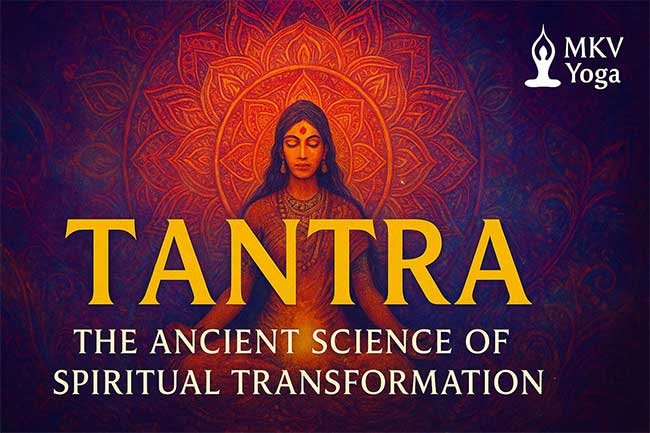Table of Contents
Introduction – Understanding the Essence of Tantra
The word Tantra comes from the Sanskrit roots “Tan” (to expand) and “Tra” (tool or instrument). Literally, Tantra’s meaning is “the tool for expansion of consciousness.” Far beyond its modern misconceptions, Tantra is an ancient spiritual science that seeks to unite the physical and the divine — guiding the practitioner toward complete awareness and liberation (moksha).
In essence, Tantra is not about ritual or indulgence — it is about transformation, energy, and inner awakening. It teaches that the divine is not outside us but within us, and through the balance of Shiva (consciousness) and Shakti (energy), one can attain ultimate bliss and enlightenment.
Origin and Meaning of Tantra
Tantra is one of the most ancient spiritual traditions of India, dating back to the Vedic and post-Vedic eras. The scriptures known as Tantras or Agamas were revealed as dialogues between Lord Shiva and Goddess Parvati, exploring deep truths about creation, energy, yoga, and consciousness.
The core philosophy of Tantra lies in understanding that everything in existence is divine, and spiritual progress comes through awareness and transformation — not rejection of the material world.
Major Branches of Tantra
Tantra is divided mainly into two broad paths:
1. Vama Marga (Left-Hand Path)
This path involves rituals, symbolism, and the awakening of kundalini through sacred practices. It emphasizes energy transformation and controlled engagement with material elements.
2. Dakshina Marga (Right-Hand Path)
A more meditative and devotional path focused on purity, self-control, mantra, and meditation. This is the path most commonly followed by seekers aiming for spiritual elevation.
Tantra in Practice – The Path of Transformation
1. Mantra (Sacred Sound)
Mantras are vibrational tools used to awaken subtle energies. Chanting specific Tantric mantras harmonizes the chakras and balances the inner energy flow.
2. Yantra (Sacred Geometry)
Yantras are powerful geometric diagrams that focus the mind and direct cosmic energy. The Sri Yantra is considered the most sacred among all.
3. Kundalini Awakening
Tantra emphasizes the awakening of Kundalini Shakti — the divine energy lying dormant at the base of the spine. When awakened through yogic practice, it ascends through the chakras, leading to a higher state of consciousness.
4. Tantra Yoga
A combination of asana (postures), pranayama (breath control), mudra (gestures), and dhyana (meditation) — Tantra Yoga aims to awaken the divine energy within and merge it with the universal consciousness.
Spiritual Benefits of Tantra Practice
-
Deep Inner Awareness: Enhances mindfulness and energy control.
-
Kundalini Activation: Awakens dormant spiritual power.
-
Balance of Shiva and Shakti: Harmonizes the masculine and feminine energies within.
-
Healing and Peace: Helps release emotional blocks and stress.
-
Path to Enlightenment: Leads to liberation (moksha) through energy transformation.
Common Misconceptions About Tantra
Modern interpretations often associate Tantra with indulgence or occult practices — but this is far from its true essence.
Authentic Tantra is a science of consciousness, designed to integrate the body, mind, and spirit through sacred discipline and awareness.
It teaches that everything — even desire, emotion, and thought — can become a tool for liberation when approached with awareness and purity.
Famous Tantric Texts and Deities
-
Kularnava Tantra
-
Rudra Yamala Tantra
-
Rahasya Tantra
-
Mahanirvana Tantra
-
Deities: Kali, Tripura Sundari, Bhairava, Tara, and Kamakhya Devi
Each text and deity symbolizes a different aspect of energy, devotion, and divine consciousness.
Tantra is not a path of indulgence but of illumination. It transforms ordinary experiences into divine expressions. Through mantra, yantra, and meditation, Tantra helps us realize that the divine exists in every atom of creation — and within ourselves. When practiced with purity, devotion, and awareness, Tantra becomes a sacred key that unlocks the highest truth of existence—the unity of the individual soul with cosmic consciousness.
FAQs – Tantra
Q1. What is Tantra in simple words?
Tantra is a sacred spiritual science that teaches the union of body, mind, and divine energy to achieve higher consciousness.
Q2. Is Tantra related to yoga?
Yes, Tantra Yoga is an integral branch that uses mantras, meditation, and energy awakening practices for spiritual growth.
Q3. Who are the main deities in Tantra?
Goddess Shakti and Lord Shiva are central figures representing cosmic energy and consciousness.
Q4. Can anyone practice Tantra?
Yes, but true Tantra should be practiced under the guidance of a qualified guru, as it involves deep spiritual and energetic processes.
You may like to read –
Kamakhya Mantra – कामाख्या मंत्र | Benefits, Meaning & Powerful Chants
Rudra Garuda Purana: Secrets of Life, Death, and the Afterlife

